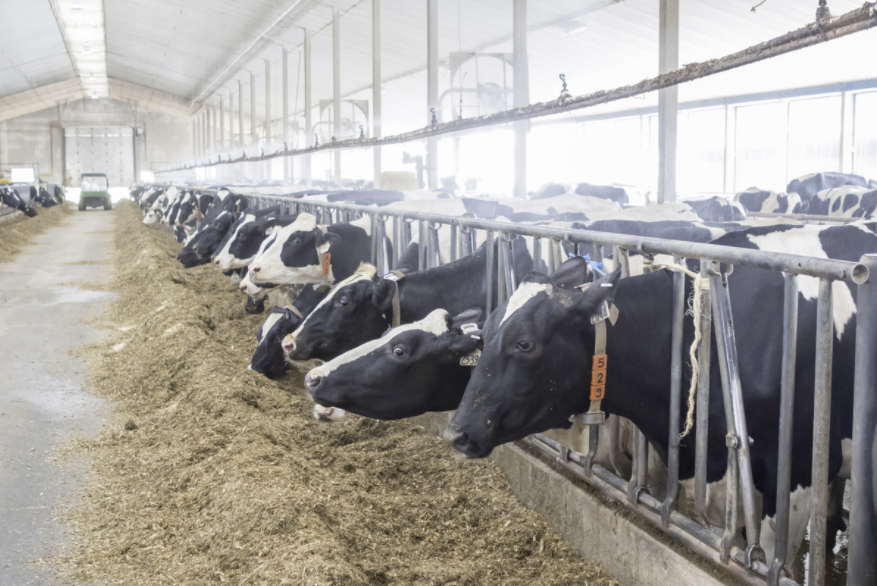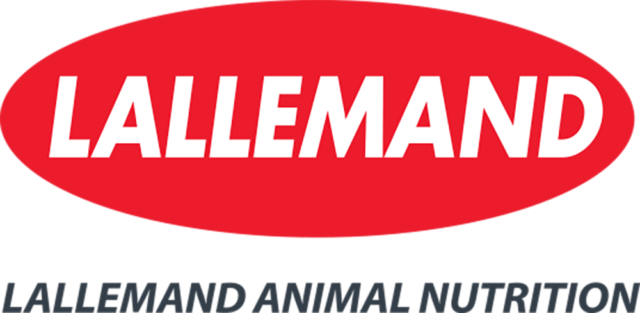Wet feedstuffs derived from the food and ethanol industries are valuable additions to cattle diets, when available within reasonable distance from the farm. They not only provide required nutrients, but their moisture content helps condition total mixed rations (TMRs), increases their palatability and reduces feed sorting by livestock. Depending on their water content and price, however, their purchase can turn into a questionable economic decision.
Where your farm is in the U.S. determines which wet feeds are readily available close enough to justify their hauling to the farm. This article addresses the wet form of beet pulp, brewers grains, distillers grains, gluten feed and grape pomace (also known as grape marc). We will discuss their composition and what factors to consider when evaluating their incorporation into dairy cattle diets.
Nutrient variability
There are multiple nutrients one could evaluate to compare feeds. In this article, we will concentrate on those macronutrients that weigh more heavily on the end price of a ration. Table 1 shows the composition of some common wet feedstuffs.
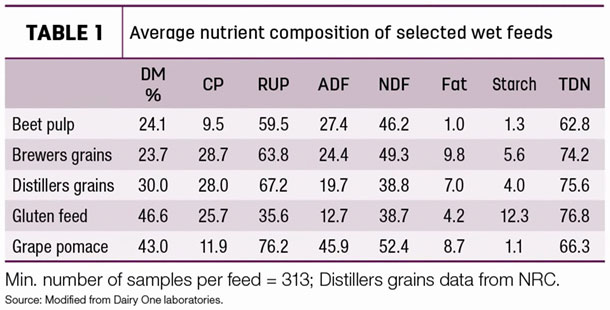
When looking at the feed composition in Table 1, the first thing that catches the eye is their dry matter (DM) and, of course, its opposite – their water content. For every ton of wet material purchased and delivered to the farm, the dry feed content ranges from around 450 pounds for gluten feed to 240 pounds for wet brewers grains and/or beet pulp. In other words, without even considering yet their nutrient contribution to the ration for every $100 spent per ton of wet feed, we get almost two times more dry product with gluten feed compared to the other two alternatives.
The remaining feedstuffs fall somewhere in the middle of these extremes. The other point to consider is the variability that exists within each feedstuffs. One would hope that for a given processing plant the product would be relatively consistent, however, this is not always the rule. Table 2 shows the spread, or maximum and minimum values, in dry matter (DM) content analyzed by the lab. Let us stress that these could be samples from different origins, however, it is still something to take into consideration.
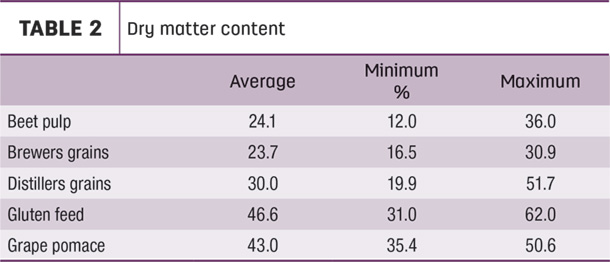
The greatest spread of all (31.8 percentage points) corresponds to wet distillers grains and the least (14.4 percentage points) to brewers grains. Again, when considering the purchase of wet products, it is necessary to speak with the plant manager to ask how consistent their product is. It seems brewers grains and grape pomace have an acceptable spread, whereas the remaining feeds deserve further scrutiny.
Nutrient content
The decision of which wet feedstuff to incorporate into the diet should be done together with your nutritionist. Depending on the rest of the feeds that often make up the diet, one feed may supply more critical nutrients than another. Protein and energy are undoubtedly the two most important drivers of feed prices, so we will concentrate on them.
Let us first look at energy content expressed in total digestible nutrients (TDN) on Table 1. For all practical purposes, there is similar energy on a DM basis for most feeds, except for two: beet pulp and grape pomace. Coincidentally, these two feeds are also the ones with the lowest protein and starch concentration of all the feeds considered. Beet pulp has the advantage of changing the pattern of fermentation in the rumen with the production of more acetate than propionate, thus reducing the risk of acidosis. Grape pomace is one of the two feeds (the other is brewers grains) that supply the most fat, at approximately 9%.
It is precisely this fat concentration that allows this byproduct to have higher energy content despite its high acid detergent fiber (ADF) concentration (45.9%). Distillers grains used to be the greatest contributor of fat to the diet, but it dropped to second place since it is currently partially defatted by nearly all ethanol plants. At the amounts usually included in the diet, neither beet pulp nor grape pomace are likely to result in earth-shattering changes in production but could help condition the TMR or stretch feed supplies when offered at an attractive-enough price.
The carbohydrate fraction is by volume the one that exerts the greatest influence in the energy content of cattle diets. We need to consider both fibrous (e.g., neutral detergent fiber – NDF – and ADF) and non-fibrous carbohydrates (e.g., starch and sugars). From Table 1, we can see there is quite a range in the fiber fraction with NDF ranging from almost 39 (distillers grains and gluten feed) to the low 50s (grape pomace). This NDF will have variable digestibility depending on its hemicellulose content. As could be expected, feeds with less hemicellulose (beet pulp 18.8% and grape pomace 6.5%) are also the ones that have less energy (62.8% and 66.3% TDN, respectively).
The fact that beet pulp has more than twice the hemicellulose than grape pomace and yet less energy is explained by the significantly higher fat content of the latter. Of the remaining feedstuffs, gluten feed has the highest hemicellulose content at 26% and the highest fat content at 12.3%, which explains why it also has the highest TDN value of 76.8%. The rest of the feedstuffs have hemicellulose contents that fall between approximately 19% and 25%, with the slight differences in TDN explained by their slightly variable fat content. The range in starch concentration for these feedstuffs goes from 1 to 12 percentage points.
Although one would be tempted to assign greater energy content with higher starch concentrations, bear in mind that all these feedstuffs have undergone different processes (including enzymatic digestion) to extract as much starch as possible. The remaining starch, while detected by analysis, is of little biological relevance since it would be more than likely refractory to any further digestion in the digestive tract.
The next nutrient to consider is protein, which ranges from around 10% to almost 29% in different wet feeds. From Table 1, there are two feeds that are clearly set apart from the rest because of their low protein content: beet pulp (9.5%) and grape pomace (11.9%). The remaining feeds are all in the 20s. The degradability of this protein will vary depending on the degradability of protein in the original feed (e.g., low zein degradability in corn grain), in addition to other changes that occurred during the process. One processing factor that affects protein degradability the most is drying temperature. In the case of wet feedstuffs, this factor is absent and thus also is the potential for heat damage in the end-product.
One of the best ways to look at this it is to compare the variation in protein degradability between these feedstuffs. The analytical values in Table 1 show there is a wide range in degradability, from a low 23.8% in grape pomace to a high 64.4% in gluten feed. For the sake of discussion, let us divide them into low degradability (grape pomace and distillers grains with 23.8% and 32.8%, respectively), medium degradability (brewers grains and beet pulp with 36.2% and 40.5%, respectively) and high degradability (gluten feed with 57.8%).
Why is this important? Because, depending on the rest of the feeds present in the TMR and cow productivity, we may either want to enhance the fermentation in the rumen, add more bypass protein or maybe even both. In the low-degradability group, we need to evaluate both feeds separately. While grape pomace has very low protein degradability, this is mostly the result of the presence of tannins and other compounds like phenols, which protect the protein from microbial degradation, which increases rumen undegradable protein (RUP).
One other possibility is to use grape pomace in diets that include forages more prone to cause bloating: for example, diets with higher concentrations of alfalfa. The situation with distillers grains is entirely different. Since corn grain has relatively high concentrations of zein (prolamin) with inherently lower degradability (approximately 50%), it is the latter that has the greatest effect on the concentration of RUP. If it’s bypass protein we are after, then distillers grains are clearly the choice. Keep in mind, however, the amino acid profile required for high-producing dairy cows.
Brewers grains and beet pulp show more moderate degradability that matches the speed of degradation of dry hay and some grass silage and would likely help maintain a healthy and balanced rumen environment when these feeds are part of the diet. Finally, gluten feed is perfectly suited for diets that contain highly degradable forage, such as those containing early-cutting haylage, immature corn silage, as well as pasture in its vegetative stage. Granted, we do not want excessive fermentation with too much gas production in the rumen that could result in bloating. If located in an area where grape pomace (high tannins) is available, it could be a good alternative to reduce this problem.
If considering the degradability of protein is important, we also need to assess how much of it is potentially entirely undegradable because of antinutritive factors and/or heat damage during processing. This can be assessed by an analysis of the crude protein tied to the ADF fraction. Table 3 shows the average, minimum and maximum concentrations of protein insoluble in the ADF fraction (ADFCP). Even though there are differences that range on average from 0.7 to 3.8, absolute values (below 7%), even at the highest concentrations, are negligible and have no biologically significant impact on protein utilization by cattle. The reason being that the highest incidence of heat damage happens during drying, which none of these byproducts had gone through.
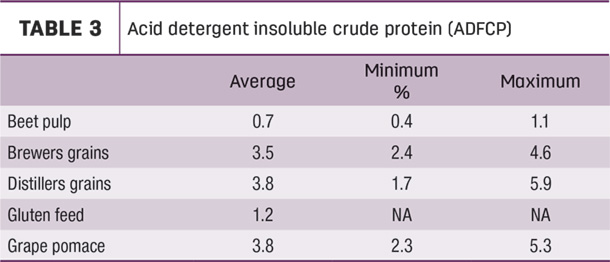
Finally, we need to remember one very important factor when utilizing wet feeds, which is shrink. With beet pulp and brewers, and depending on the type of truck used for transportation, first losses could happen while hauling feed between the processing plant and the farm. Ideally, one should weigh feeds upon arrival, however, only large farms have a scale on site. Secondly, losses also happen when feed is stored even under the best conditions. There are seepage losses as well as spoiled (moldy/crusty) feeds that need to be discarded. These losses have been reported to be within 15% and 30%.
Wet feeds are very attractive because they condition the TMR and allow for a more homogeneous intake of the ration cows are supposed to eat. Nevertheless, always try to choose the right feed to complement the right ration, and make sure that losses between shipping and feeding do not exceed the economic benefits of their inclusion in the diet.
